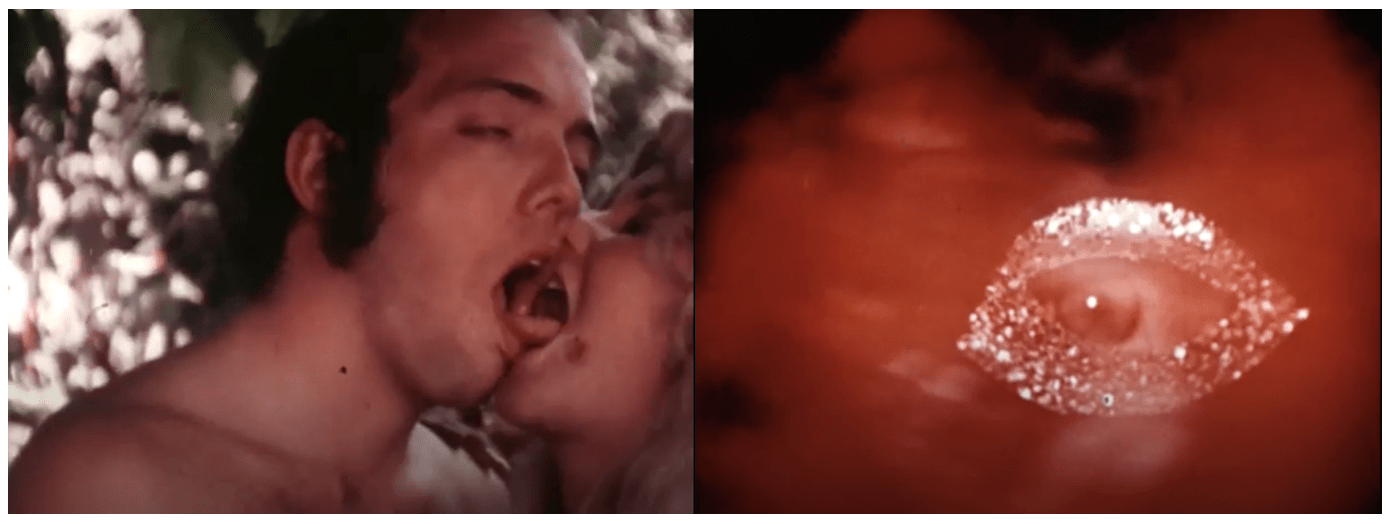
“Director” Larry Crane made 7 films between 1967 and 1969. All Women Are Bad was made in 1969, right after Sugar Daddy and right before The Love Captive. All Women Are Bad is less a misogynist treatise and more a sleazy sexploitation movie, but it’s also a weird “descent into madness” narrative told in the style of a Raymond Chandler novel, if ol’ Raymond had been drinking peyote instead of gin.
All Women Are Bad is one of those super low-budget, black-and-white affairs shot with no sound and with narration dubbed in post-production. An endearing quality of such films is their tendency to have the narrator explain what is being said while actors silently roleplay an exchange of dialogue. It undermines the whole purpose of film and is a strange sight to behold.
There are some truly unusual choices made in the production of All Women Are Bad that set it apart from the conventional cheapo sexploitation flick. The film opens with our world-weary narrator coming home from a hard day's work. He is a door-to-door salesman and returns home early only to find his wife in bed with another man. He stands by the bed and watches for awhile while they exchange sloppy kisses and fumble around with each other’s flesh. For some reason, the couple does not notice his presence.

The salesman (we never learn his name) leaves the scene and goes on what is best described as a walkabout somewhere in New Jersey. He climbs hills and philosophizes about life and love and whatever. Then he decides to take the ferry across the Hudson River to take his revenge on his wife by partying in the in the Big Apple. As the ferry makes its way across the waters, he wonders to himself, “Lila, at this point I didn’t care if I would ever see her again. Somewhere in the crowd, in the big city, I’d find another woman, someone soft, someone loving, someone… different. But was I fooling myself? In the canyons of steel and stone, under the cover of darkness, it shouldn’t be difficult.”
I don’t know what the hell he is talking about, but it gives you a taste of the writing. The monologue is followed by what may be my favorite part of the movie. It’s an 8-minute montage of a Hudson River ferry docking. I’ve ridden that ferry plenty of times and docking is a pretty boring procedure, but Larry Crane is determined to commit it to celluloid. I’m sure he filmed it guerrilla style, just standing amidst the commuters with his 16mm. In an attempt to inject some urgency into the imagery, Larry provides us with a blow-by-blow of what is going on in the salesman’s mind.

“As the ferry drew near the New York skyline, I felt my pulses [strangely plural] tingle with excitement and anticipation.”

“Well, the trip had been brief enough, but now we were here, getting off was going to be interminable. I could foresee that.”

“We pulled in closer and closer to the dock. As we did my excitement mounted.”

“I could hardly wait to leave the boat.”

“How long would it take?”

“Everybody was waiting and so was I.”

“Impatiently.”

“Anxious to get ashore.”
The rest of the film takes place in Manhattan. The salesman takes a lascivious tour of the city’s seedy underbelly. The film starts off rooted in the real world, where the salesman has to peek through keyholes to witness sexy shenanigans, but eventually Larry dispenses with any pretense of plausibility and allows the salesman magical access to all that is going on behind closed doors. The salesman just suddenly finds himself watching an S&M party, or a necrophiliac having his way with a topless corpse. It’s a little like Charles Dickens's A Christmas Carol, where Scrooge gets to see everything without being seen, but this time Scrooge is visited by the ghost of 42nd Street.

Larry tries to cover a wide array of sexual practices, including foot fetishes, tickling, stripping, gay love of both the female and male kinds. The lesbian scene fits easily into what you would expect in your average sexploitation film, but watching two men was rare at that time. If it had been 1967, Larry could very easily have been thrown in jail, but All Women Are Bad was made in 1969, after the repeal of the Hayes Code. We don’t see our two young men kiss on the lips, but there is a peck on the cheek, some fondling, and even an implied blow job. Of course one of them is an over-the-top stereotype, as you can see below.

All Women Are Bad gets more interesting as it starts to fall apart. In order to show that the salesman is turning into a voyeuristic maniac, the editing gets looser, a little more free form. Larry has one woman smoke opium, which gives him license to start playing weird music and projecting patterns on her body.
With each encounter, the salesman’s narration gets increasingly agitated. The narration is his inner monologue and consists of one long puritanical diatribe about how all these women are evil for indulging themselves.
To his great distress, each encounter ends with the woman in the scene morphing into his wife Lila. This confuses and agitates him until he suddenly finds himself inexplicably wrapped in a straight jacket. He manages to rip it off, only to find that his wife’s breasts have appeared on his chest. The close-up of the breasts is actually recycled footage from a previous stripper scene. The breasts have freckles and so are easily distinguishable as the stripper's breasts as opposed to his wife’s. There is a lot of recycling of images in the film. Some of the salesman’s reaction shots are taken from earlier scenes. This results in some strange mismatched backgrounds and/or lighting. If it was deliberate, it might have been an attempt at conveying the salesman’s disorientation, but I doubt it.
In the end, Larry takes the easy way out and we see the salesman wake up in his bed next to his wife Lila. It’s the old “it was all a dream” ending. Very lazy, Larry.
All Women Are Bad fulfills its role as a cheap and sleazy bit of smut, but it’s clear that Larry wanted it to also have meaning and possibly a moral. Whatever he is trying to say isn’t very clear, but it isn’t that all women are bad. The movie title is pulled from a third-person quote from the salesman. If anyone is bad, it seems like Larry is pointing us toward the salesman. The salesman represents the conservative view of women which forbids their sexual expression and pleasure.
Larry assumes the audience has come to the theater to see something naughty and forbidden, but the narrator chastises them for these desires. It’s not as simple as Larry dressing up a sex film in conservative clothing, which was certainly a common strategy at the time. There were plenty of films that claimed to provide warnings against perversion while simultaneously providing salacious examples of it. I can’t say that Larry wasn’t doing this as well, but the salesman is a conflicted character being driven mad by sexual urges he does not approve of.

It’s not just that the salesman is puritanical, he is also demented. While watching two young women dressing up for a night out, he thinks to himself, “Women, so lovely, charming, prettying themselves. For what? To trap men of course, and talk about them behind their backs!” He is afraid of women, afraid of how they can dominate him sexually and socially.
These feelings reflect a central theme in the late 1960s and 1970s. The birth control pill first became available in 1960 and was followed by a wave of mixed emotions for both genders. The title of Larry’s film could have been All Women Have Sexual Desires and been marketed as a horror movie, where shocked audiences are both titillated and terrified by female desire.

In the end, when the salesman wakes up safe in his bed next to his wife, she urges him to wake up and go to work. He looks at her and suddenly flashes back to all that he has seen in his dream. It’s a very long and thorough montage, but when it’s finally over, the salesman dutifully gets up and the movie ends. It’s a last-minute and uncertain reaffirmation of society’s patriarchal norms. The film isn’t about bad women. It isn’t about women at all. It’s a film made by a man, about men, meant to be watched by men. As a man, you can indulge in your own special mixture of arousal, excitement, fear, and anger. In this way, the women depicted in the film become a Rorschach test for the audience. They don’t get to speak, but as objectified symbols, they become potent signifiers of an uncertain society.
I’m not sure Larry meant to convey such academic stuff, but he knew that men and women were both curious and nervous about sexual liberation and All Women Are Bad intentionally addresses this.

If you enjoyed this article you might also enjoy - https://filmofileshideout.com/archives/she-mob-a-diamond-in-the-rough-real-rough-baby/



